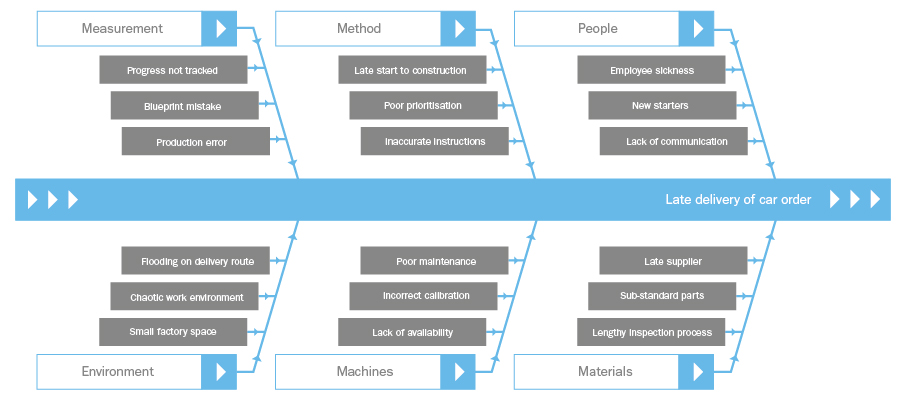The 8D method was originally the brainchild of the Ford Motor Company. The concept was developed in the 1980s and was initially given the moniker TOPS (Team Oriented Problem Solving) due to its emphasis on a team approach.
This approach proved to be incredibly effective, and the process has now been adopted by other companies to root out their own problems. Now known as Global 8D, the method is ideally suited to manufacturers, but it’s also been effectively used in healthcare, retail, finance and government sectors.
What is the 8D problem-solving method?
‘8D’ stands for the eight disciplines of problem-solving. Each discipline of the tool supports businesses in finding the root cause of a non-conformity and implementing a permanent solution. This detailed and disciplined approach makes it a valuable method for boosting quality and reliability within your business.
Its methodology also puts a great deal of emphasis on what is referred to as the problem-solving team. By bringing different people together, you can take advantage of their diverse experience as well as rapidly develop their individual problem-solving skills.
Other benefits include:
- Greater problem-solving efficiency
- The discovery of any necessary systemic changes
- The creation of a document trail and database outlining non-conformities and their solutions
- Better understanding of non-conformities within the business and their solutions
How do I use the 8D method?
To help you through your problem-solving journey, here is a step-by-step guide through the eight dimensions.
0D: Planning
This stage is not an official part of the eight-step process, but it remains crucial for the method to work.
Before you begin to problem-solve, you need a plan of action. Start gathering evidence on the issue, whether it is a series of customer complaints, a defective product or a process that was not carried out correctly. This will help you decide upon your team and will kick-start the investigation.
1D: Find a team
Now you have an idea of the issue, it’s time to assemble your team.
Try to choose people from different departments within the business but remember to include those who are familiar with the processes linked to the non-conformity/issue. This team can shift as your investigations continue, so be prepared to call in other expertise as you learn more about the events leading up to the issue.
To keep things moving, make sure a leader is elected. Ideally, they should be someone who is familiar with the 8D process.
2D: Problem identification
At this stage you need to set down a description of the problem. This should be fact-based and focused on information taken from business data. By doing this, you can narrow down the issue and start to rule out possible causes of the non-conformity.
To help you create an accurate description, you may like to base it on the 5W2H methodology (who, what, where, when, how and how much?).
3D: Temporary correction
Now that you have a good idea of what the problem is, you may need to put a temporary corrective action in place.
This won’t resolve the root cause of the issue, but it will help to protect your customer from receiving bad products or service from your business.
Interim measures could include stopping production or replacing defective parts, for example.
4D: Root cause analysis
We’re now getting to the business end of this process. At this stage, you can begin to identify the root causes of the non-conformity and verify them using facts gleaned from your data collection.
To help you identify the true cause of the problem, take advantage of other problem-solving techniques, such as the five whys.
The five ways is a very straightforward technique in which you ask the question ‘why’ for every answer you generate.
Here’s an example:
How to use the five whys
Problem: Water spillage in the factory.
1. First why: The water spillage occurred because the factory pipeline was leaking.
2. Second why: The factory pipeline leaked because it was damaged.
3. Third why: The factory pipeline was damaged due to poor maintenance.
4. Fourth why: The pipeline was poorly maintained because it wasn’t checked regularly.
5. Fifth why: It wasn’t checked regularly because there isn’t a maintenance schedule for the pipelines.
Root cause: A missing maintenance schedule
Other techniques include the fishbone diagram, which is illustrated below. In this example, the non-conformity was a late delivery. If using the fishbone method, you won’t necessarily fill every section – it will depend on the type and scale of problem you are investigating.

You may also like to walk through your business’ processes to discover the exact location of the root cause. In this case, a process flow diagram may be useful. This is essentially a flowchart that illustrates the relationship between major components.
5D: Permanent correction
Once you are happy that you have found the root cause of your issue, it is time to put together a permanent corrective action. This action will replace the temporary measures you put in place.
In the case of the factory water spillage, the permanent corrective action will be to create a new maintenance schedule to prevent excessive damage.
When you have a plan of what to do, you need to establish its probable effectiveness before you put it into action. Simulations or tools such as Accelerated Life Testing (ALT) can be handy for this. ALT is useful in manufacturing as it tests a product by subjecting it to extreme conditions. Once you’re satisfied that you have found the right solution, it’s time to move to the next stage.
6D: Implementation
It’s now time to implement your chosen permanent corrective action.
To implement it correctly, you need to create a project plan that covers communication to the relevant work teams and overseers as well as the steps to completion. Make sure you also decide how you will measure your success.
7D: Prevention
This stage is dedicated to making sure you prevent the non-conformity from reoccurring.
For example, in the case of the water spillage from the pipeline, the preventative action will be to communicate the new maintenance checks to the relevant team and to issue training on how to check the pipes.
Sharing your knowledge and the lessons learned during the fact-finding process is also key. Make sure the problem and its resolution are communicated to the rest of the business and update documents and your ISO processes.
You may also like to take a look at related products or procedures to see if similar problems are occurring in different parts of the business.
8D: Feedback
The last discipline is dedicated to rewarding your problem-solving team and recognising their efforts. Feed back on their performance and highlight any areas for improvement – this will help them to develop their problem-solving skills and tighten up the process during the next investigation. Once that’s done, it’s time to celebrate!
Need some extra support?
Running a management system and playing detective when it comes to non-conformities can be quite challenging when you’re juggling other business needs.
For more support or guidance, you can reach our team of experts by calling 0333 344 3646 or emailing [email protected].
